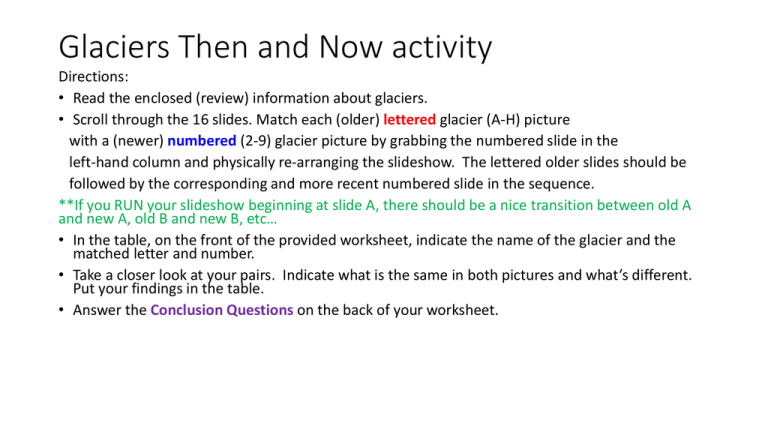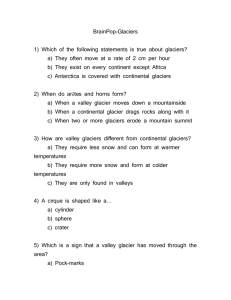Glaciers Then and Now slideshow
advertisement

Glaciers Then and Now activity Directions: • Read the enclosed (review) information about glaciers. • Scroll through the 16 slides. Match each (older) lettered glacier (A-H) picture with a (newer) numbered (2-9) glacier picture by grabbing the numbered slide in the left-hand column and physically re-arranging the slideshow. The lettered older slides should be followed by the corresponding and more recent numbered slide in the sequence. **If you RUN your slideshow beginning at slide A, there should be a nice transition between old A and new A, old B and new B, etc… • In the table, on the front of the provided worksheet, indicate the name of the glacier and the matched letter and number. • Take a closer look at your pairs. Indicate what is the same in both pictures and what’s different. Put your findings in the table. • Answer the Conclusion Questions on the back of your worksheet. BACKGROUND INFORMATION: • Glaciers are either one of two types: a continental glacier, also called an ice sheet, such as those that occur on Antarctica, or an alpine or valley glacier found in mountain valleys. The photographs in this activity are all alpine glaciers from Alaska, US. Alpine glaciers occur all over the world, yet require specific climate conditions to survive. This usually includes a location that has high snowfall in the winter and cool temperatures in the summer to prevent snow from melting. • If a glacier is to form in a given location, snow must accumulate over time, turn to ice, and begin to flow under the pressure caused by its own weight and gravity. As more and more snow accumulates over years, decades, centuries and longer periods of time, the glacier continues to move. In areas with little snowfall or low slope conditions, the glacier will flow downward and outward very slowly. If the ice is on a steep slope, if basal conditions are smooth and soft, and if there is high snowfall, then the glacier will flow faster. Often this rapid motion creates crevasses on the glacier's surface. • Glacier retreat occurs as a result of sublimation (transition of ice to vapor), snow evaporation (evaporation of liquid water in the snow), strong scouring winds, and ice melt. The process of a glacier getting smaller is called ablation. Over the past 60 to 100 years, almost all glaciers worldwide have been getting smaller and in most cases there is strong evidence that current glacier retreat is due to Earth's warming climate. This is most evident for alpine glaciers in the Arctic, which is warming quickly compared with other regions, and for alpine glaciers at high elevations in tropical latitudes. After matching the pics (letters to numbers), answer these Conclusion Questions the on back of your worksheet: • 1. What common things stayed the same? What were common changes? • 2. Do all the glaciers in this sample follow the same pattern? Are they growing, retreating, or staying the same? • 3. What climate conditions encourage glacier growth and retreat? • 4. As glaciers get smaller, how might this affect the Earth? • 5. Are humans affected by melting glaciers? What are the risks and benefits to human populations? • 6. How did it take for these changes to take place? A B C D E F G H








